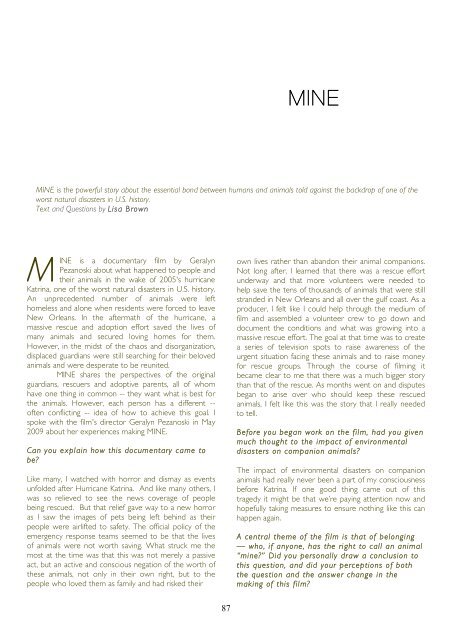M - Antennae The Journal of Nature in Visual Culture
M - Antennae The Journal of Nature in Visual Culture
M - Antennae The Journal of Nature in Visual Culture
You also want an ePaper? Increase the reach of your titles
YUMPU automatically turns print PDFs into web optimized ePapers that Google loves.
M<br />
INE is a documentary film by Geralyn<br />
Pezanoski about what happened to people and<br />
their animals <strong>in</strong> the wake <strong>of</strong> 2005's hurricane<br />
Katr<strong>in</strong>a, one <strong>of</strong> the worst natural disasters <strong>in</strong> U.S. history.<br />
An unprecedented number <strong>of</strong> animals were left<br />
homeless and alone when residents were forced to leave<br />
New Orleans. In the aftermath <strong>of</strong> the hurricane, a<br />
massive rescue and adoption effort saved the lives <strong>of</strong><br />
many animals and secured lov<strong>in</strong>g homes for them.<br />
However, <strong>in</strong> the midst <strong>of</strong> the chaos and disorganization,<br />
displaced guardians were still search<strong>in</strong>g for their beloved<br />
animals and were desperate to be reunited.<br />
MINE shares the perspectives <strong>of</strong> the orig<strong>in</strong>al<br />
guardians, rescuers and adoptive parents, all <strong>of</strong> whom<br />
have one th<strong>in</strong>g <strong>in</strong> common -- they want what is best for<br />
the animals. However, each person has a different --<br />
<strong>of</strong>ten conflict<strong>in</strong>g -- idea <strong>of</strong> how to achieve this goal. I<br />
spoke with the film's director Geralyn Pezanoski <strong>in</strong> May<br />
2009 about her experiences mak<strong>in</strong>g MINE.<br />
Can you expla<strong>in</strong> how this documentary came to<br />
be?<br />
Like many, I watched with horror and dismay as events<br />
unfolded after Hurricane Katr<strong>in</strong>a. And like many others, I<br />
was so relieved to see the news coverage <strong>of</strong> people<br />
be<strong>in</strong>g rescued. But that relief gave way to a new horror<br />
as I saw the images <strong>of</strong> pets be<strong>in</strong>g left beh<strong>in</strong>d as their<br />
people were airlifted to safety. <strong>The</strong> <strong>of</strong>ficial policy <strong>of</strong> the<br />
emergency response teams seemed to be that the lives<br />
<strong>of</strong> animals were not worth sav<strong>in</strong>g. What struck me the<br />
most at the time was that this was not merely a passive<br />
act, but an active and conscious negation <strong>of</strong> the worth <strong>of</strong><br />
these animals, not only <strong>in</strong> their own right, but to the<br />
people who loved them as family and had risked their<br />
87<br />
MINE<br />
MINE is the powerful story about the essential bond between humans and animals told aga<strong>in</strong>st the backdrop <strong>of</strong> one <strong>of</strong> the<br />
worst natural disasters <strong>in</strong> U.S. history.<br />
Text and Questions by Lisa Brown<br />
own lives rather than abandon their animal companions.<br />
Not long after, I learned that there was a rescue effort<br />
underway and that more volunteers were needed to<br />
help save the tens <strong>of</strong> thousands <strong>of</strong> animals that were still<br />
stranded <strong>in</strong> New Orleans and all over the gulf coast. As a<br />
producer, I felt like I could help through the medium <strong>of</strong><br />
film and assembled a volunteer crew to go down and<br />
document the conditions and what was grow<strong>in</strong>g <strong>in</strong>to a<br />
massive rescue effort. <strong>The</strong> goal at that time was to create<br />
a series <strong>of</strong> television spots to raise awareness <strong>of</strong> the<br />
urgent situation fac<strong>in</strong>g these animals and to raise money<br />
for rescue groups. Through the course <strong>of</strong> film<strong>in</strong>g it<br />
became clear to me that there was a much bigger story<br />
than that <strong>of</strong> the rescue. As months went on and disputes<br />
began to arise over who should keep these rescued<br />
animals, I felt like this was the story that I really needed<br />
to tell.<br />
Before you began work on the film, had you given<br />
much thought to the impact <strong>of</strong> environmental<br />
disasters on companion animals?<br />
<strong>The</strong> impact <strong>of</strong> environmental disasters on companion<br />
animals had really never been a part <strong>of</strong> my consciousness<br />
before Katr<strong>in</strong>a. If one good th<strong>in</strong>g came out <strong>of</strong> this<br />
tragedy it might be that we’re pay<strong>in</strong>g attention now and<br />
hopefully tak<strong>in</strong>g measures to ensure noth<strong>in</strong>g like this can<br />
happen aga<strong>in</strong>.<br />
A central theme <strong>of</strong> the film is that <strong>of</strong> belong<strong>in</strong>g<br />
— who, if anyone, has the right to call an animal<br />
“m<strong>in</strong>e?” Did you personally draw a conclusion to<br />
this question, and did your perceptions <strong>of</strong> both<br />
the question and the answer change <strong>in</strong> the<br />
mak<strong>in</strong>g <strong>of</strong> this film?












